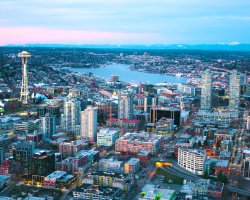Washington State Takes Big Pharma to Trial

After two decades of what may be America’s worst drug addiction crisis, state attorneys general are beginning to come together and demand that the pharmaceutical companies who contributed to the crisis be held accountable. One attorney general, Washington State’s Bob Ferguson, is going even further than most.
New Developments in Washington State
In an alarming legal turnaround, Washington State Attorney General Bob Ferguson recently moved his state’s case against big pharma away from a multi-state negotiated settlement. Instead, he brought Washington’s case against the nation’s three biggest drug distributors to trial.
This is a startling development because while attorneys general from several U.S. states were willing to settle with pharma distributors over the role those distribution companies played in the opioid epidemic, Washington State seems unwilling to accept a settlement. Instead, Washington State wanted to take pharmaceutical drug distributors to trial to truly hold them accountable for their role in creating America’s opioid addiction epidemic.
“These companies knew what would happen if they failed to meet their duties. We know they were aware of the harms flowing from their conduct because in private correspondence, company executives mocked individuals suffering the painful effects of opioid dependence. They displayed a callous disregard for the communities and people who bear the impact of their greed.”

AG Ferguson brought the case to the King County Superior Court with these remarks, “These companies knew what would happen if they failed to meet their duties. We know they were aware of the harms flowing from their conduct because in private correspondence, company executives mocked individuals suffering the painful effects of opioid dependence. They displayed a callous disregard for the communities and people who bear the impact of their greed.” Those words served as the beginning of the trial, and it set the tone for why Washington State refused to settle.
Of course, the risk that comes with taking McKesson Corp., AmerisourceBergen Corp., and Cardinal Health Inc. to trial rather than accepting a settlement with them is that if Washington State loses its case, the state may not receive any funds. And this has happened recently too. Earlier this year the Oklahoma Supreme Court overturned a $465 million judgment against Johnson & Johnson in a similar case, and judges in Washington could potentially rule the same way against the state AG’s bid to hold pharma distributors accountable.
But in AG Ferguson’s defense, Washington laws are quite different from Oklahoma laws, and he and his legal team feel that their bid to hold pharma giants accountable under Washington State’s public nuisance law (and under state consumer protection law) will win out in the end. The AG wants the nation’s three largest pharma distributors (which also happen to be three of the largest corporations in the nation) to pay out $38 billion over 15 years. The payments will be used to fund treatment services for addicts, to pay criminal justice costs, fund public education campaigns for local communities, and maintain other programs that will help repair the damage caused by the opioid epidemic.

Opioid sales in Washington State rose more than 500% between 1997 and 2011, even though reported pain levels among Washington State residents did not increase. And pharma executives, which are supposed to have warning systems in place to alert executives when prescription drug orders surge, did nothing.
In 2011, more than 112 million individual doses of prescription opioids were being distributed out into the public every day, enough to supply every Washington State resident with a 16-day supply of drugs. And pharma execs still did nothing.
By 2015, eight of Washington’s 39 counties had more prescriptions than residents, and still, pharma execs did nothing.
And even though Washington State doctors, patients, public health officials, and policymakers eventually got wise to what was going on and took measures in their state to curb prescribing, now heroin addiction and fentanyl addiction is a huge crisis-level problem in the state, with heroin/fentanyl deaths quintupling from 2010 to 2018. Still, pharma execs have done nothing.
All of the above ties into big pharma’s negligence and priority of profit over public health. Quoting the Washington State Attorney General’s legal brief, “This [heroin and fentanyl deaths] occurred as a foreseeable result of users’ addiction, particularly for those who could no longer obtain or afford prescription opioids. These deaths and other heroin and fentanyl-related harms thus are an integral and tragic part of the opioid epidemic and public nuisance.” In summary, even though Washington State took matters into its own hands to curb incoming pills from distributors, other opioids cropped up in the place of prescription opioids, further plaguing residents.
The Opioid Epidemic and How Pharma Distributors Contributed to It

The crucial complaint against pharma distributors is simple enough. When the Washington State attorney general’s office initially sued McKesson Corp., AmerisourceBergen Corp., and Cardinal Health Inc. back in 2019, it was on the grounds that the pharma distributors made billions of dollars off the opioid epidemic by shipping obscenely huge amounts of prescription painkillers into the state, even when the distributors knew that the drugs would find their way into the hands of addicts, dealers, and drug-dependent “patients.”
And then, even when it became more than apparent that an opioid addiction epidemic was spreading in Washington State, pharma distributors continued to send millions upon millions of doses of addictive pain meds to the state, allegedly ignoring their companies’ own warning systems and procedures.
The effects of this negligence on the people of Washington State were devastating. According to the National Institute on Drug Abuse:
- Opioids cause at least 63% of fatal overdoses in Washington State.
- Between 1999 and 2017, death totals from prescription opioids soared above death totals for synthetic opioids and heroin, with deaths from synthetic opioids only barely eclipsing deaths from prescription opioids in 2018.
- In 2018, the most recent year with published figures, 737 people died from overdoses on opioid drugs.
Washington State’s prescription drug addiction crisis is beginning to curve downwards, but only after more than two decades of devastation. Furthermore, hundreds of thousands of people living in the state struggle with addictions to opioid pain relievers, synthetic opioids, heroin, and other drugs.
Prescription Opioid Addiction and Treatment
There is no doubt that those who struggle with an addiction to opioid drugs are in a constant state of risk, a daily life-or-death struggle. Opioid addiction can very easily become a fatal affliction, given the high risk for overdoses. That’s why the family members and loved ones of addicts must know how to spot opioid addiction. They also must know what to do to help their loved ones seek treatment.
In Washington State and the nation, no one needs to struggle with an addiction to drugs or alcohol any longer. And while it makes sense and is a noble mission to hold pharma giants accountable for their role in creating the opioid epidemic, the most important goal must be treating those who are still addicted to opioids. That’s how lives are saved. That’s how, one rehabilitated addict at a time, the harm done by pharma giants is gradually nullified.
Sources:


 ®
®